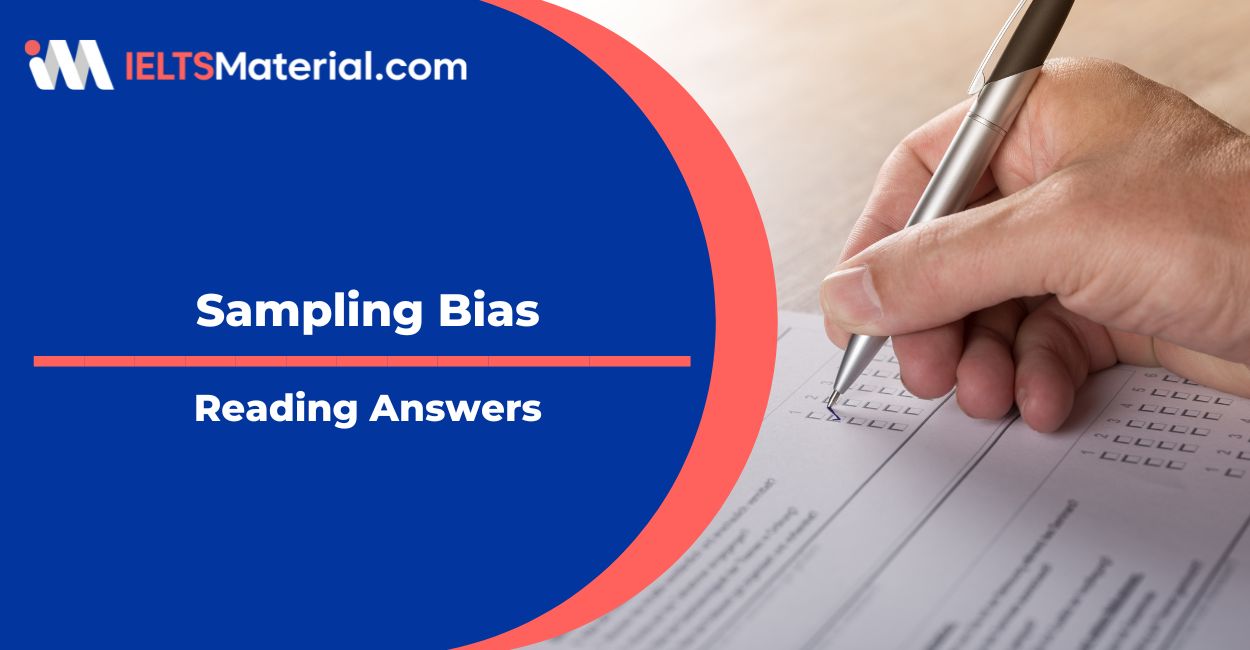Sampling Bias Reading Answers
2 min read
Updated On
-
Copy link
Table of Contents

Limited-Time Offer : Access a FREE 10-Day IELTS Study Plan!
This article contains the Sampling Bias reading answers.
Sampling Bias is a real Reading test passage that appeared in the IELTS.
With diligent practice, the Reading Module can be the top-scoring category for IELTS Aspirants. To score well, you must understand how to approach and answer the different question types in the Reading Module.
By solving and reviewing Sample Reading Questions from past IELTS papers, you can ensure that your Reading skills are up to the mark. Take the practice test Sampling Bias below and try more IELTS reading practice tests from IELTSMaterial.com.
Not sure how to answer IELTS Reading Flow Chart questions? Check out the video below for the latest tips and strategies!
For more Multiple Choice Questions practice, take a look at IELTS Reading Multiple Choice Example 1!
Sampling Bias
You should spend about 20 minutes on Questions 14-26, which are based on the Reading Passage below. Find the practice test with the Sampling Bias PDF here.
Answers
| Question number | Answer | Keywords | Location of keywords |
|---|---|---|---|
| 14 | NOT GIVEN | – | – |
| 15 | TRUE | Surveys, for example, are popular because they are easy to administer and relatively cost-effective, particularly if conducted remotely through technical means, such as telephone, | Paragraph B;
Line 1 |
| 16 | FALSE | Such surveys, however, have proven notoriously unreliable because of the difficulty in obtaining representative samples. | Paragraph B;
Line 5 |
| 17 | TRUE | Those that answer will more likely be the unemployed, disabled, elderly, and retired, | Paragraph C;
Line 4 |
| 18 | FALSE | This allows easy collation, analysis, and presentation of results, all with the air of precision that mathematics brings. | Paragraph B;
Line 4 |
| 19 | self-selection | One of the more subtle of sampling biases is known as self-selection. | Paragraph D;
Line 1 |
| 20 | Opinionated perspectives | opinionated perspectives are disproportionately represented. | Paragraph D;
Last line |
| 21 | Maximise (the) | The latter is such an immediate and obvious problem that it has given rise to techniques to maximise the possibility of garnering responses. | Paragraph E;
Line 1 |
| 22 | Sufficiently trained | The interviewers themselves must be sufficiently trained in correct question-asking techniques, | Paragraph E;
Last line |
| 23 | introduction | interviewers must provide introductions about themselves, their company, and the nature of the interview, fully and with evident sincerity, | Paragraph E;
Last line |
| 24 | trust | interviewers must provide introductions about themselves, their company, and the nature of the interview, fully and with evident sincerity, in order to gain the trust of those they are talking to. | Paragraph E;
Last line |
| 25 | B | Even with this, sampling bias can easily arise due to the number of variables in place, since it only takes one to skew the data. | Paragraph F;
Line 1 |
| 26 | C | mathematical extrapolations to correct the bias. For this to work, the degree of underrepresentation needs to be quantified exactly, | Paragraph G;
Lines 1- 2 |
Check More IELTS Reading Answers
Also check :
Practice IELTS Reading based on question types

Start Preparing for IELTS: Get Your 10-Day Study Plan Today!
Recent Articles

Nehasri Ravishenbagam

Haniya Yashfeen

Haniya Yashfeen

Haniya Yashfeen




Post your Comments
1 Comment